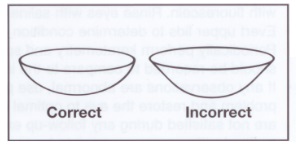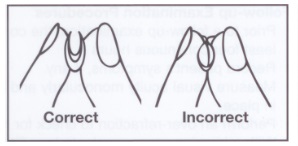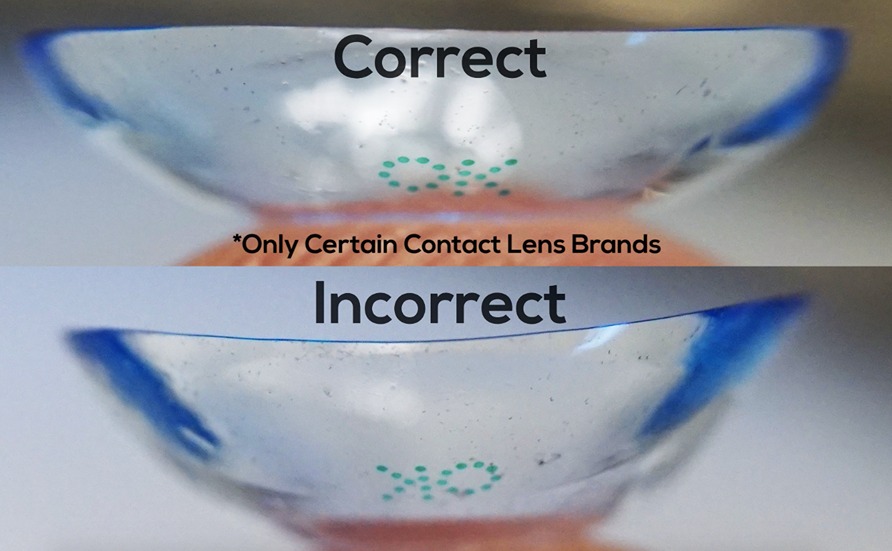If upon insertion, your contact lens or lenses feel uncomfortable or move about too much then this is a common indicator that they may be inside out.
There are two easy ways to tell if your contact lens is inside out, look at the shape of the contact lens, it should have a smooth curved appearance, like a well-turned bowl, or squeeze the lens between your thumb and finger, and the edges of the contact should roll inwards.
It is recommended to look at your lens before inserting it, this will help you get the lens in the right way. It is easy to skip this step, particularly as lenses are rarely inside out. For many contact lens wearers, particularly in the early days, it can be difficult to tell if a lens is inside out or not just by sight alone, and it's not until the lens is actually in the eye that they realise something doesn't feel quite right
Most contact lens wearers instantly feel eye discomfort when they put their lenses in the wrong way. However, other wearers may only feel the lens is moving slightly too much, or feel like it won't "settle", and there are a few wearers who don’t feel immediate symptoms and might not feel eye discomfort until later in the day.
Common complaints associated with inside-out contact lenses include:
- Too much lens movement
- Frequently blinking
- Vision not as corrected as it normally is
- Blurry vision
- Eye pain
- Red eyes
- Itchy eyes
Soft lenses that are properly fitted are designed to feel comfortable. So, if you feel your contacts are “off” even slightly, you should remove them, and check to make sure they are facing the correct way.
How To Tell If Your Lenses Are Right-Side Out
1. Look At The Edges

Our optometrists' advice to check whether your lenses are facing the right way out is to focus on the edges. If your lens is facing the right way, then the edges will look curved and smooth like a bowl. Lenses that are "inside-out", however, will have edges that jut out at the top creating a small lip.
Do this in good lighting and try to hold the lens as close to your eyes as possible when using this method. It can take a little practice to become a pro at this, as the difference is quite slight.
2. The Squeeze Test

If you still have doubts about your lenses after the edge inspection? You can try the squeeze test.
As the name suggests, to use this method you gently squeeze one contact lens in half with your thumb and forefinger. Next, take a close look at how the edges of the contacts are curved.
What you want to see are smooth edges that roll inwards and somewhat resemble a taco (a common nickname for this method is the “taco test”). By contrast, contact lenses that are facing the wrong way will roll outwards.
3. Inspect For A Manufacturer’s Seal

Manufacturers understand how difficult it can be for new contact lens wearers to determine an inside-out contact lens. That’s why many companies nowadays print symbols on their contacts that can help you easily and accurately determine which way your contact is facing.
Brands such as Acuve for example have a 1 2 3 indicator, which you can see clearly when the lens is held up to the light and the right way out.
If you struggle to differentiate between inside-out and right-side-up lenses, then you might want to ask your optometrist about contact lenses with inside-out indicators.
Are Inside-Out Lenses Dangerous?
In most cases, wearing inside-out lenses won’t pose a major risk to your eye health, especially if it’s not an everyday occurrence. However, there’s always a risk that an inside-out contact lens could cause significant eye discomfort and exacerbate certain eye conditions. For instance, patients who have dry eye syndrome often notice a dramatic increase in discomfort symptoms with 'inside-out' lenses.
Regularly wearing lenses that are inside out could potentially lead to corneal issues like corneal scratching, which could lead to infection.
Another problem with wearing inside-out lenses is that they have a greater tendency to accidentally fall out of your eyes. This is especially true if you’re involved in high-impact sports or have a habit of rubbing your eyes.
Conclusion
A contact lens that is inside out is more of an irritation than a serious health issue, but by simply removing the lens and inverting it before reinserting the lens can ensure you'll have comfortable wear all day.
Author: John Dreyer Optometrist Bsc(Hons), MCOPTOM, DipCLP
Created: 19 Feb 2024, Last modified: 25 Feb 2024

